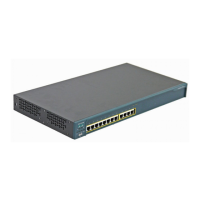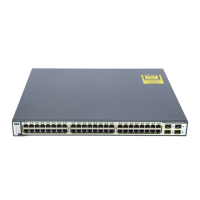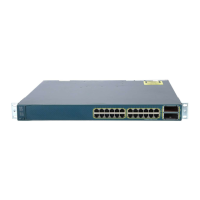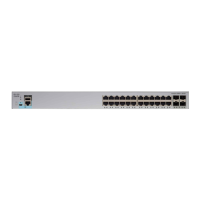24-4
Catalyst 6500 Series Switch Software Configuration Guide—Release 8.7
OL-8978-04
Chapter 24 Configuring NSF with SSO MSFC Redundancy
Types of MSFC Switchovers
Types of MSFC Switchovers
The types of MSFC switchovers are as follows:
• Failover—An MSFC failover occurs when the active MSFC crashes or detects a serious system
failure and ends up in ROMMON.
• Forced switchover—A forced switchover is caused by either entering a CLI command or by removing
the supervisor engine with the active MSFC from the chassis. The MSFC CLI commands that force a
switchover are the redundancy force-switchover and reload commands. The supervisor engine CLI
command that forces a switchover is the reset mod command where mod is the module number of
the MSFC as shown in the show module command display.
Configuration Guidelines and Restrictions
This section describes the configuration guidelines and restrictions for configuring NSF/SSO:
• If SSO is enabled on the MSFC, you must enable high availability on the supervisor engine before
upgrading to supervisor engine software release 8.5(1) and later releases. Use the set system
highavailability enable command to enable high availability on the supervisor engine.
• SSO replaces SRM and DRM. There is no support for these high-availability modes. The details are
as follows:
–
SRM CLI processing—Cisco IOS Release 12.2(18)SXF and later software releases contain the
SRM CLI. The CLI is accepted when entered but it is not acted on in any way. The SRM CLI
was kept in Cisco IOS Release 12.2(18)SXF and later software releases to assist you in
migrating to NSF/SSO. However, the SRM CLI does not cause NVRAM updates. If you have
SRM CLI in your configuration and you decide to modify the SRM configuration and enter the
write mem command, the SRM CLI commands in the configuration are lost. If you want to
downgrade to an image that has SRM, your original SRM CLI configuration is lost and you will
have to reconfigure SRM. For this reason, we recommend that you save your configuration
before you upgrade from SRM to NSF/SSO.
–
DRM CLI processing—Unlike SRM CLI, any existing DRM CLI in the configuration file after
upgrading to NSF/SSO are flagged as errors at system startup. You must reconfigure the switch
and remove the DRM configuration. We recommend that you save your configuration before
you upgrade from DRM to NSF/SSO.
• During a switchover, there will be traffic loss for traffic that is routed by the MSFC. NSF only
applies to traffic that is hardware switched by modules and the switch fabric. New flows are not
allowed until the switchover is complete.
• In cases where the MSFC has failed and is unable to notify the supervisor engine of the failure, the
supervisor engine may take 30 to 40 seconds before it realizes that the MSFC has failed and a
switchover is triggered. If the supervisor engine receives the failure notification, the switchover is
triggered immediately.
• The Frame Relay, ATM, and PPP protocols that are not supported in SSO mode.
• WAN modules react to SSO switchovers as follows:
–
WAN modules do not reload with an SSO switchover.
–
WAN module interfaces go down and then come back up during an SSO switchover.
–
All routing protocols do not perform NSF if NSF is configured over WAN interfaces.
–
All features on the WAN interfaces resume operation after an SSO switchover.
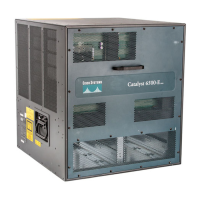
